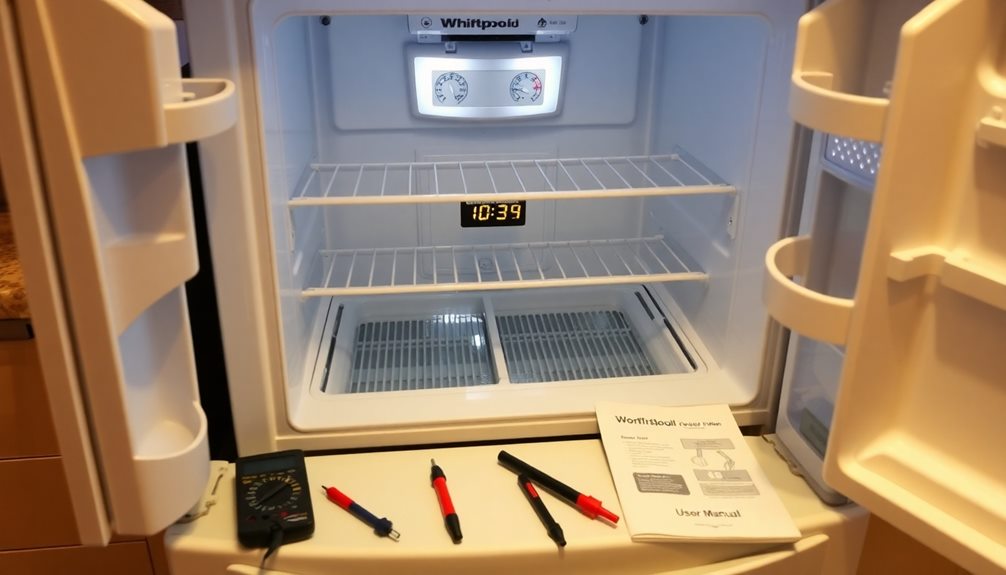If you’re confused by ice cream maker terms, you’re not alone. Understanding the difference between gelato and sorbet helps you choose the right recipe—gelato is creamier, while sorbet is dairy-free and lighter. Churn rate controls how much air is in your ice cream—higher churn means fluffier texture, lower makes it denser. Tuning techniques allow you to adjust consistency and prevent issues like icy sorbet or overly dense gelato. Keep exploring to master these concepts and craft perfect frozen treats every time!
Key Takeaways
- Churn rate determines how quickly the ice cream maker stirs, affecting texture and fluffiness.
- Gelato is creamier with less air, while sorbet is dairy-free and lighter, influencing machine and recipe choices.
- Tuning techniques adjust machine settings to control ice crystal size, texture, and consistency.
- Proper ingredient ratios and churning help prevent issues like icy sorbet or overly dense gelato.
- Understanding these terms improves troubleshooting, recipe development, and your overall ice cream making skills.

Understanding ice cream maker terms can help you navigate the world of frozen treats more confidently. When you’re shopping for an ice cream maker or reading recipes, you’ll encounter terms that can seem confusing at first. One common comparison you might see is gelato vs sorbet, which often sparks questions about ingredients, texture, and preparation methods. Gelato tends to be creamier and richer because it uses more milk and less air, whereas sorbet is dairy-free and relies on fruit purees and sugar, making it lighter and more invigorating. Recognizing these differences helps you choose the right machine and recipe for what you crave.
Another important term to understand is churn rate explanations. The churn rate refers to how quickly your ice cream maker stirs or mixes ingredients during the freezing process. A higher churn rate means the machine stirs faster, incorporating more air into the mixture, which results in a lighter, fluffier ice cream. Conversely, a lower churn rate produces a denser, creamier texture since less air gets incorporated. Many modern ice cream makers come with adjustable churn rates, giving you control over the consistency of your frozen treats. Knowing what churn rate your machine offers can help you tailor your recipes to achieve the texture you prefer, whether that’s a soft-serve style or a dense gelato.
Additionally, tuning techniques can significantly influence the final texture and performance of your frozen dessert, just as tuning in Hyundai vehicles enhances their driving experience. Understanding these terms not only helps you make better choices but also allows you to troubleshoot if your frozen dessert doesn’t turn out quite right. For example, if your sorbet feels too icy or icy, it could be due to insufficient churning or a low churn rate. If your gelato isn’t as creamy as you’d like, it might be worth checking whether your machine’s churn rate is appropriate for that texture. Proper ingredient ratios are also essential in achieving the perfect consistency and flavor, similar to how tuning in Kia vehicles optimizes their performance. Plus, awareness of air incorporation helps you understand how texture and volume are affected during the freezing process. Recognizing these factors empowers you to experiment confidently, adjusting settings or ingredients to get the perfect result.
In essence, familiarizing yourself with ice cream maker terminology transforms you from a casual consumer into an informed enthusiast. Whether you’re deciding between gelato vs sorbet or trying to understand the impact of churn rate explanations, grasping these concepts helps you create frozen treats tailored exactly to your taste. It also makes the process more enjoyable, as you’ll better understand how your equipment works and how to optimize it. So, next time you read about churn rates or compare gelato and sorbet, you’ll know precisely what they mean and how they influence your delicious creations.
Frequently Asked Questions
How Long Does It Take to Make Ice Cream in a Machine?
Making ice cream in a machine usually takes about 20 to 40 minutes, depending on your machine’s storage capacity and the recipe. You should also consider the cleaning process afterward, which can add extra time. Keep in mind that larger capacity machines might take a bit longer to churn, but they often produce more ice cream. Stay patient for a delicious result!
What’S the Difference Between Churn and Freeze Cycles?
Imagine you’re making ice cream at home; the churn process involves stirring the mixture to incorporate air, creating a smooth texture. The freeze cycle then cools the mixture, solidifying it. The churn process happens during the initial phase, while the freeze cycle continues until your ice cream reaches the desired consistency. Understanding these cycles helps you control texture and quality, ensuring your ice cream is perfectly creamy and scoopable.
Can I Use Regular Ingredients in All Ice Cream Makers?
You can usually use regular ingredients in most ice cream makers, but ingredient variations might affect texture and freezing time. Some machines handle recipe customization better, allowing more flexibility with ingredients like fresh fruit or nuts. Always check your user manual for specific guidelines, especially if you’re experimenting with unique or heavy ingredients. This way, you guarantee your homemade ice cream turns out creamy and delicious every time, regardless of ingredient choices.
Do All Ice Cream Makers Require Pre-Freezing Bowls?
Imagine the anticipation, the chill in the air, as you prepare your ice cream. Not all ice cream makers require a pre-freeze; many have a built-in compressor, removing the need for bowl freezing. But if your model relies on bowl freezing, you’ll need to pre freeze the bowl beforehand to guarantee smooth, creamy results. So, check your machine’s pre freeze requirement—your perfect scoop depends on it.
How Loud Are Typical Ice Cream Machines During Operation?
You wonder about the noise levels of ice cream machines during operation. Typically, they produce around 60 to 80 decibel ratings, similar to a normal conversation or background noise. While some models are quieter, others can be louder, especially during extended use. If noise is a concern, look for machines specifically designed for quieter operation, as this can make your ice cream making experience much more enjoyable without disturbing your environment.
Conclusion
Now that you’re familiar with ice cream maker terms, you’re ready to create sweet masterpieces with confidence. Think of it like learning a new language—at first, words seem unfamiliar, but soon they become part of your vocabulary. I once struggled with the difference between churn and freeze, but after experimenting, I realized it’s like riding a bike; once you get it, it all clicks. So, immerse yourself and enjoy your delicious, homemade ice cream journey!








